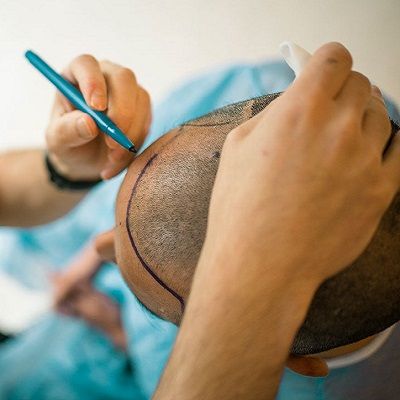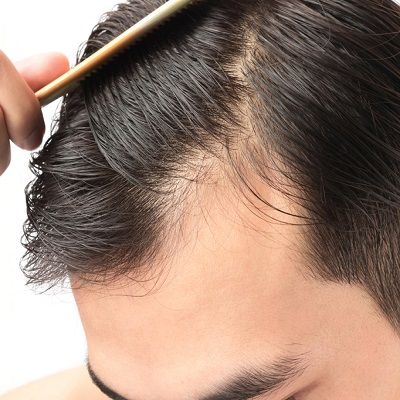
A hair transplant is one of the most common cosmetic surgery treatments, with people preferring it for various reasons. However, not all of these treatments are successful, and some patients are concerned that their baldness may persist after the transplant. The following information will assist you in determining how long a hair transplant procedure can last and whether or not patients can bald post-surgery.
Hair Growth and Male Pattern Baldness:
During the growing phase, each hair root goes through a cycle that lasts a few years as the individual hair lengthens, and a resting phase that lasts a few months when the hair falls out, after which the hair root creates new hair.
In males with male pattern baldness, however, the roots on both the front and crown of their heads begin to enter a longer resting cycle and a shorter growth period, finally ceasing to develop.
Increased sensitivity to the male hormone dihydrotestosterone (or DHT), which is known to induce follicular shrinkage, and hereditary predisposition are also factors that contribute to hair loss.
Men who fall victim to male pattern baldness usually opt for a hair loss treatment in Dubai, such as PRP or FUE hair transplant, to mitigate or correct the effects of shedding.
Balding after Hair Transplant:
The newly transplanted hair may shed for the first 3 to 5 months in a phase known as the ugly duckling phase. After that, they behave similarly to other strands.
Ninety percent of surgically grafted hair follicles will most likely never fall and last the patient their entire life.
Grafts taken from the correct donor zone typically last forever because these follicles are genetically wired to be resistant to DHT and hair loss. However, if an unskilled doctor removes follicles from a hazardous donor location, these follicles will fall out and suffer from DHT-induced hair loss.
Hair transplants, therefore, last a lifetime provided that the follicles are transplanted from a safe area. However, the line between safe and unsafe regions is not precise and often varies from person to person.
In some cases, if the hair is transplanted from a safe donor region, this particular region may be too close to the non-safe area and, therefore, could be sensitive to DHT, causing the patient to shed hair.
While the treatment can cause most of the transplanted hair to remain 90% permanent, the accuracy of the results depends upon multiple factors that will determine post-transplant hair fall.
Factors Affecting Post-Transplant Baldness:
Two main factors determine the likelihood of baldness after a hair transplant. The first aspect has to do with the reason for getting this surgery done. If you have alopecia or another medical disease that causes hair loss, you could run the risk of turning bald following a transplant.
The age at which you get hair transplant surgery is the second factor. For most people, severe hair loss may start to happen in their twenties or early thirties due to medical illnesses or hereditary factors. These people may immediately decide to undergo hair transplant surgery without waiting for most of the hair to shed. This may lead to unforeseen baldness after the procedure.
Other factors that could lead to baldness or hair shedding after a transplant include poor nutrition, stress, and excessive smoking.
How to Avoid Rapid Hair Loss After a Hair Transplant:
There are a few things patients can do to guarantee that their hair transplant gives them long-term results.
Maintaining a Healthy Diet:
The food that people eat usually determines the health of their hair, which is why patients must adhere to a balanced and nutritious eating plan, as whatever they consume will show up on their heads. Avoiding junk food, and processed meals with high sugar content, carbohydrates, and unhealthy fats can help you minimize serious health concerns and increase the growth rate of the transplanted hair.
Timing of the Surgery:
When patients receive treatment too soon, they might notice hair thinning following their transplant. This is because hair from a portion of the scalp that was about to fall out might be extracted for the procedure. Before committing to surgery, patients must understand how far their hairline will recede and the total amount of balding they could experience.
Picking a Skilled Surgeon:
Baldness following a hair transplant might be the result of a surgeon who is unskilled or poorly trained. A professional hair specialist may consider the patient’s age, medical history, and other variables when determining the best time for surgery and the best procedure that suits them.
Efficient research is required when selecting the right surgeon.
Avoiding Strenuous Activity During Recovery:
After undergoing a hair transplant in Dubai, patients are usually advised by the doctor not to partake in strenuous activities such as swimming or exercising. This is due to the damage that sweat or other substances may cause to the grafts on your head, leading to poor hair growth results.
Patients should wait at least two weeks before resuming any physical activities.
Final Words!
Baldness after a hair transplant is therefore dependent on many factors from both the surgeon’s and patient’s sides. Determining the right time for the procedure and researching the doctor’s expertise can help patients receive a much more successful outcome.
Contact our expert specialists at Dynamic Aesthetic Clinic Dubai and book a free consultation for more help regarding hair loss treatments such as PRP in Dubai.











